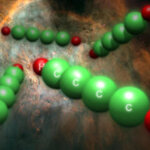Space

What is really happening in apparently empty areas of the Galaxy? It may get a rethink because scientists have managed to find a molecule that has an unexpectedly complicated structure in interstellar clouds of extremely small density.
Translucent interstellar clouds are penetrated by highly energetic ultraviolet and cosmic radiation which should break any chemical species it meets but a group of scientists have managed to observe in those clouds a molecule made up of an unexpectedly large number of atoms: the diacetylene cation; a discovery which may contribute to solving the…

I'm a nice guy launching a nice little musical satellite. But what if I were a super-villain? What if _you_ were a super-villain and launching your own satellite? Think-- and listen (or read) too-- how much damage can you do from (pico)-space, my latest podcast for "365 Days of Astronomy". And now let's expand on that.
The podcast itself is a re-recording of the Ignite! talk I gave at SpaceUpDC, itself based on a question raised by a Science20 reader. Namely, do we risk disaster by letting any yahoo launch their own satellite?
Put another way, WWDDD?
What…

Strange so-called Green Pea galaxies were first discovered in 2007 by citizen scientists and it has now been shown that these extraordinary and extremely compact star cities have low amounts of complex elements after being diluted by streams of gas and strong supernova winds.
Green Pea galaxies were discovered by participants in Galaxy Zoo, which grew out of the need to provide more help to astronomers with a huge number of night sky images produced by the Sloan Digital Sky Survey.
These citizen scientists discovered a strange type of galaxy that did not fit with previously known types…

In case you do not easily panic, you may have missed the story that two asteroids were passing close to Earth yesterday. Not to worry, it happens all of the time, but because their existence was only discovered Sunday by the Catalina Sky Survey, people were concerned.
The 50-foot 2010 RX30 came within 154,000 miles of Earth, just over halfway from here to the moon (0.6 lunar distances if you want to impress your friends), yesterday morning and then 2010 RF12, about 30 feet in size, came within 50,000 miles of Earth yesterday afternoon.
Well, why mention it? They got a lot of…

NGC 300 is one of the closest and most prominent spiral galaxies in the southern skies, about six million light-years away and bright enough it can be seen with binoculars. NGC 300 lies in the constellation of Sculptor with only a few bright stars, but is home to a collection of nearby galaxies that form the Sculptor Group, though recent distance measurements show that NGC 300 lies significantly closer to us than many of the other galaxies in the group and may be only loosely associated with them. Compared to other galaxies, NGC 300 is remarkably normal, making it an ideal specimen for…

I like rocket photos and was getting a little jealous looking at all the Copenhagen folk's photos. Where were my rocket's photos? I'm launching the Project Calliope music satellite with Interorbital Systems (IOS) and even I don't know what my rocket looks like!
At last month's SpaceUpDC meeting, though, a saavy rocket guy name Ben R. had a radical idea. He suggested I ask for photos. Imagine that! So I came up with a great plan. Having also met a fellow named Kirk W. who had interned with IOS, I thought I'd drug Kirk's coffee, hook up some encephalogram receivers…

Edges are where topics intersect. Edges are where uncomfortable thoughts reside. Edges define a topic by being just barely part of that topic. They are the border between what is known, and what is speculative.
Working around edges requires new methods, disruption, and massive creativity. Web2.0 is about breaking the border between reader and creator. Science2.0 is about expanding the choices of how we do science. The new space race and things like the X-Prize are about breaking down the old framework of space exploration to make new methods. Heck,…

Our universe is thought to be around 14 billion years old and astronomers recently determined that big galaxies formed much earlier in the universe's history than previously thought, within the first 1 billion years, and for more than two decades the prevailing wisdom among astronomers has been that galaxies evolved hierarchically - gravity drew small bits of matter together first and then those small bits gradually came together to form larger structures.
A new model seeks to turn that idea on its head. And the researchers say the very large umbrella of 'dark matter' may be the…

"We're building a rocket. We're building it bigger" - Copenhagen Suborbital."We've got the biggest balls of them all" - AC/DC
I'll steal UniverseToday's summary, then tell you to skip reading everyone else's coverage of it (even mine):
Copenhagen Suborbitals, headed by Kristian von Bengtson and Peter Madsen, hope to launch the world’s first amateur-built rocket for human space travel. As of this writing, the launch countdown clock on the Copenhagen Suborbitals’ website reads 7 days and 12 hours, which would put the launch on August 30 at about 1300 GMT.
Let's skip the boring blah…
Previously undetected landforms indicate the Moon is ... shrinking.
Lobate scarps are thrust faults that occur primarily in the Moon's lunar highlands. They were first recognized in photographs taken near the moon's equator by the panoramic cameras flown on the Apollo 15, 16 and 17 missions. Fourteen previously unknown lobate scarps have now been revealed in very high resolution images taken by Lunar Reconnaissance Orbiter Camera. The newly detected scarps indicate that the thrust faults are globally distributed and not clustered near the moon's equator.
"One of the remarkable aspects…